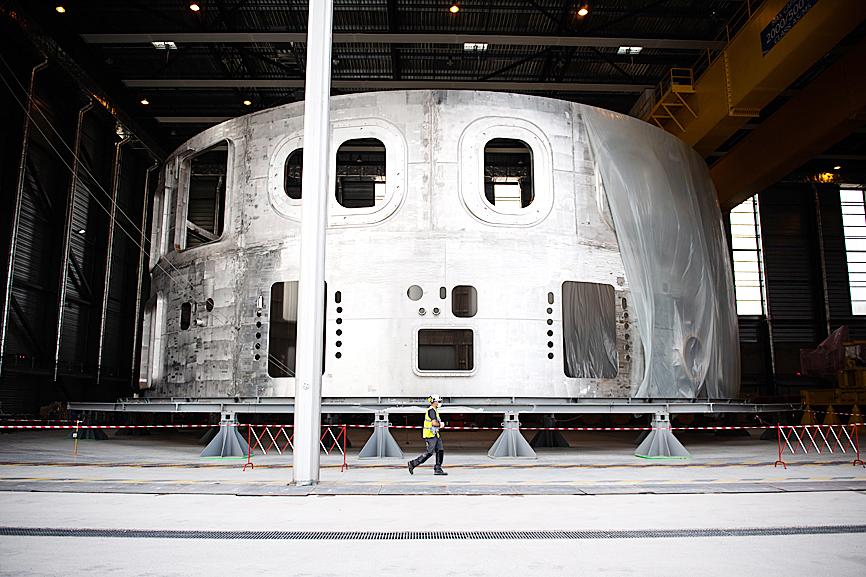Work has begun to assemble giant components to build an experimental nuclear fusion reactor in France that is expected to start up in 2035 and deliver energy in a process inspired by the sun, the ITER project said on Tuesday.
Launched in 2006, the International Thermonuclear Experimental Reactor (ITER) had planned to test its first super-heated plasma by this year and achieve full fusion by 2023.
However, it has suffered massive budget overruns and multiple delays as the seven partners — Europe, the US, China, India, Japan, Russia and South Korea — struggle to coordinate financing and technological cooperation.

Photo: AFP
“Constructing the machine piece by piece will be like assembling a three-dimensional puzzle on an intricate timeline,” ITER director-general Bernard Bigot said in a statement on Tuesday. “We have a complicated script to follow over the next few years.”
ITER confirmed that when assembly is completed in December 2025, it will launch first plasma, which should prove the reactor concept works.
Despite delays caused by the COVID-19 pandemic, ITER was still on track to start in full power mode in 2035, a spokeswoman said.
In the past few months huge components — many weighing several hundred tonnes each — have begun to arrive in France.
These have been produced by ITER consortium member states, who contribute to the project by manufacturing components in national factories and laboratories before shipping them to France.
Unlike fission reactors, which produce energy by splitting atoms, ITER would generate power by combining atoms in a process similar to the nuclear fusion that produces the sun’s energy.

BOMBARDMENT: Moscow sent more than 440 drones and 32 missiles, Volodymyr Zelenskiy said, in ‘one of the most terrifying strikes’ on the capital in recent months A nighttime Russian missile and drone bombardment of Ukraine killed at least 15 people and injured 116 while they slept in their homes, local officials said yesterday, with the main barrage centering on the capital, Kyiv. Kyiv City Military Administration head Tymur Tkachenko said 14 people were killed and 99 were injured as explosions echoed across the city for hours during the night. The bombardment demolished a nine-story residential building, destroying dozens of apartments. Emergency workers were at the scene to rescue people from under the rubble. Russia flung more than 440 drones and 32 missiles at Ukraine, Ukrainian President Volodymyr Zelenskiy

COMPETITION: The US and Russia make up about 90 percent of the world stockpile and are adding new versions, while China’s nuclear force is steadily rising, SIPRI said Most of the world’s nuclear-armed states continued to modernize their arsenals last year, setting the stage for a new nuclear arms race, the Stockholm International Peace Research Institute (SIPRI) said yesterday. Nuclear powers including the US and Russia — which account for about 90 percent of the world’s stockpile — had spent time last year “upgrading existing weapons and adding newer versions,” researchers said. Since the end of the Cold War, old warheads have generally been dismantled quicker than new ones have been deployed, resulting in a decrease in the overall number of warheads. However, SIPRI said that the trend was likely

‘SHORTSIGHTED’: Using aid as leverage is punitive, would not be regarded well among Pacific Island nations and would further open the door for China, an academic said New Zealand has suspended millions of dollars in budget funding to the Cook Islands, it said yesterday, as the relationship between the two constitutionally linked countries continues to deteriorate amid the island group’s deepening ties with China. A spokesperson for New Zealand Minister of Foreign Affairs Winston Peters said in a statement that New Zealand early this month decided to suspend payment of NZ$18.2 million (US$11 million) in core sector support funding for this year and next year as it “relies on a high trust bilateral relationship.” New Zealand and Australia have become increasingly cautious about China’s growing presence in the Pacific

Indonesia’s Mount Lewotobi Laki-Laki yesterday erupted again with giant ash and smoke plumes after forcing evacuations of villages and flight cancelations, including to and from the resort island of Bali. Several eruptions sent ash up to 5km into the sky on Tuesday evening to yesterday afternoon. An eruption on Tuesday afternoon sent thick, gray clouds 10km into the sky that expanded into a mushroom-shaped ash cloud visible as much as 150km kilometers away. The eruption alert was raised on Tuesday to the highest level and the danger zone where people are recommended to leave was expanded to 8km from the crater. Officers also